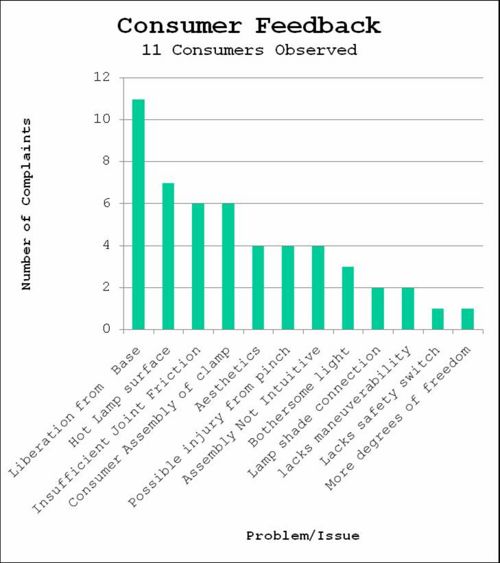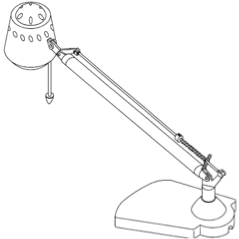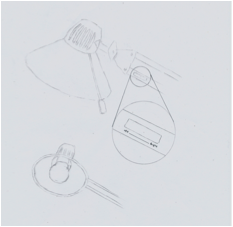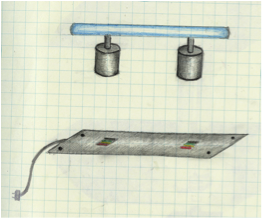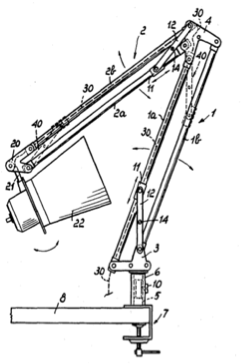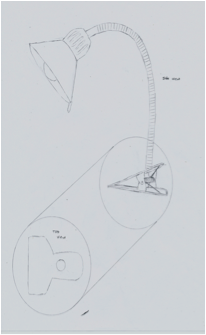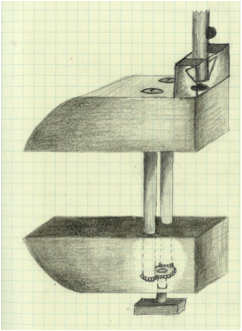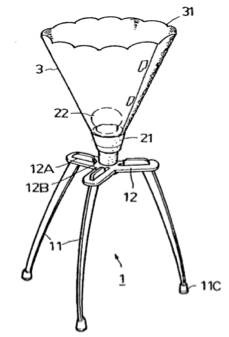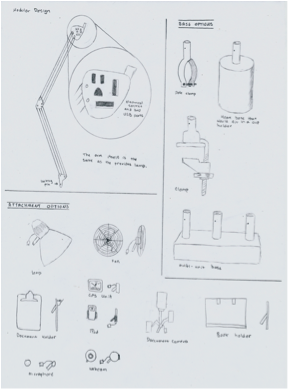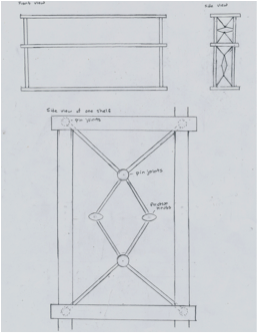Lamp stand mechanical arm redesign
From DDL Wiki
(→'''Mechanical''') |
(→'''Pugh Charts''') |
||
| Line 140: | Line 140: | ||
| align="center" | 8 | | align="center" | 8 | ||
|} | |} | ||
| + | |||
| + | The weight is higher for the good lighting parameter because this specific pugh chart focuses on design ideas pertaining to lighting. Design 1 stays with the same idea as the Standard design, but is more flexible, safer, and has better lighting. Design 2 goes in a different lighting direction than the Standard Design and has much better lighting. Both designs are better than the Standard Design and have very close scores. | ||
==='''Mechanical'''=== | ==='''Mechanical'''=== | ||
| Line 206: | Line 208: | ||
| align="center" | 8 | | align="center" | 8 | ||
|} | |} | ||
| + | |||
| + | The weight is higher for the flexible parameter because this specific pugh chart focuses on design ideas pertaining to the mechanical aspect of the lamp. Design 1 uses a different arm than the Standard Design. The gooseneck allows the lamp to move and stay in almost any direction. Design 2 focuses on improving the base of the Standard Design. The base keeps the lamp arm from falling out and has a more secure hold on the surface it attaches to. Both designs are much better options than the Standard Design. | ||
==='''New Designs'''=== | ==='''New Designs'''=== | ||
| Line 272: | Line 276: | ||
| align="center" | 1 | | align="center" | 1 | ||
|} | |} | ||
| + | |||
| + | The weight is higher for the easy to use parameter because this specific pugh chart focuses on design ideas that are completely new and focus on the consumer's needs. Design 1 uses interchangeable bases and payloads, which creates more functions for the arm and gives the consumer many options. Design 2 goes in a completely different direction than a lamp and focuses on the target market's needs. Since the target market is college students and universities, adjustable shelves are a great addition to any dorm room or office. However, Design 2 doesn't score high in safety or lighting, which gives it a low score in comparison to the Standard Design and Design 1. | ||
=='''Recommendations'''== | =='''Recommendations'''== | ||
Revision as of 16:47, 7 October 2008
Contents |
Executive Summary
Design Objectives
The main design problem with this desk lamp is stability while maneuvering the lamp to the desired position. According to research (explained in detail below), the main issue with this desk lamp is stability during use. The lamp either liberates itself from the base during use or it does not stay in the desired location. Both of these issues account for roughly a 31% of the complaints with the lamp. The need to address the issue of stability while maneuvering is, therefore, the primary design problem.
The secondary design problems with the desk lamp would be the high temperature of the lamp shade during use and the difficult assembly of the clamp when attaching the base to the surface. These together account 25% of the complaints with the lamp (There were more consumers concerned with the temperature of the surface rather than the clamp attachment issue).
Results of Research
The graph to the right shows the result of our ethnographic study how 11 users interacted with the lamp and their feedback or concerns. These people are all part of the focus market segment of students, universities and offices.
The participants agreed unanimously that the liberation of the base during maneuvering is a major safety issue; one even citing it as the prime reason she doesn’t buy this type of lamp. The users in the study either experienced the liberation issue while maneuvering the lamp or had prior experience with this lamp where it liberated itself from the base. 11% of the consumers agreed that the lack of friction in the joints is also a concern when maneuvering the lamp; the lack of friction overtime this will prevent the lamp from staying where it is placed. The need to tighten the friction knobs just right also caused a lack of sufficient friction because the users did not intuitively know when sufficient friction was reached.
14% of the participants also expressed concern about the temperature of the lamp shade. This is because most participants hold the lamp shade while maneuvering the lamp. A hot surface would then eliminate all degrees of freedom associated with the lamp head. 11% also had difficulty assembling the clamp that secures the base to the surface. This was mainly due to the complex “look” of the base and that one must use 2 hands to clamp the base to the surface
The other responses occurred in less than half the complaints about the product. Some of these issues will be addressed indirectly through the other design improvement, but these are not the focus of our efforts.
Patent Search & Key Findings
Links to Existing Patents
Please put some pros and cons for each
Key Ideas
This section should include things like...most of the designs address issue X, but don't address issue Y
Description of Solutions
Modular Base
This design concept features modular attachments on both upper and lower termini at the ends of the arm. On the upper termini there are 2 USB ports and one electrical outlet. There are a variety of attachment options available each serving a different niche group. F The base is dealt with in a similar manner. It has modular attachments that serve different purposes depending on the users need.
The needs of the customer are also met and exceeded in some
Positive Features
- Reaches many markets because of many functions
- Small problems with previous mechanical parts are solved (Locking pin in base prevents the pieces from liberating on their own)
- Large number of possible attachments allow for further innovation and marketing
Negative Features
- Many parts make compact packaging more difficult & limits number of standard attachment options
- Heavy base is cumbersome
- Storage needed for bases and attachments that are not currently being used
Market Analysis
Gwendolynn this is your part here. Here put things like how for the touch switch the elderly would like this a lot & for the modular one that each extra module could add more possibilities for extra clients
Goose Neck Lamp
The Goose Neck Lamp solution has a lamp on the end of Goose Neck. The method chosen to attach this design to the bases was a simple clamp. This solution addresses various concerns of the customer. Given the right surface to connect to, the Goose Neck is very stable while being maneuvered into position. The clamp now requires virtually no assembly, addressing the complexity in the prior clamp. The high temperatures seen in the current design would be indirectly addressed by attaching a handle to the shade that allows the user to move the lamp without touching the lamp. A foil inner liner for the lamp shade also helps to reflect radiation and keep the lamp shade as cool as possible.
Positive Features
Negative Features
More flexibility at the cost of stiffness.
Market Analysis
Magnetic Base with Current
Positive Features
Negative Features
Market Analysis
Ceramic Lamp Shade
Positive Features
Negative Features
Market Analysis
Pugh Charts
Lighting
The weight is higher for the good lighting parameter because this specific pugh chart focuses on design ideas pertaining to lighting. Design 1 stays with the same idea as the Standard design, but is more flexible, safer, and has better lighting. Design 2 goes in a different lighting direction than the Standard Design and has much better lighting. Both designs are better than the Standard Design and have very close scores.
Mechanical
The weight is higher for the flexible parameter because this specific pugh chart focuses on design ideas pertaining to the mechanical aspect of the lamp. Design 1 uses a different arm than the Standard Design. The gooseneck allows the lamp to move and stay in almost any direction. Design 2 focuses on improving the base of the Standard Design. The base keeps the lamp arm from falling out and has a more secure hold on the surface it attaches to. Both designs are much better options than the Standard Design.
New Designs
The weight is higher for the easy to use parameter because this specific pugh chart focuses on design ideas that are completely new and focus on the consumer's needs. Design 1 uses interchangeable bases and payloads, which creates more functions for the arm and gives the consumer many options. Design 2 goes in a completely different direction than a lamp and focuses on the target market's needs. Since the target market is college students and universities, adjustable shelves are a great addition to any dorm room or office. However, Design 2 doesn't score high in safety or lighting, which gives it a low score in comparison to the Standard Design and Design 1.
